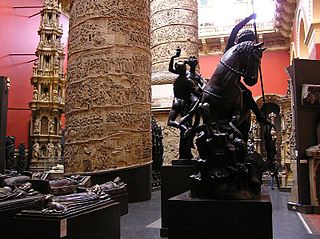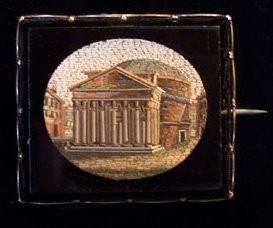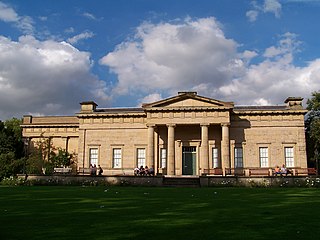
The Los Angeles County Museum of Art (LACMA) is an art museum located on Wilshire Boulevard in the Miracle Mile vicinity of Los Angeles. LACMA is on Museum Row, adjacent to the La Brea Tar Pits.

The National Museum of Ireland is Ireland's leading museum institution, with a strong emphasis on national and some international archaeology, Irish history, Irish art, culture, and natural history. It has three branches in Dublin, the archaeology and natural history museums adjacent on Kildare Street and Merrion Square, and a newer Decorative Arts and History branch at the former Collins Barracks, and the Country Life museum in County Mayo.

The Neue Galerie New York is a museum of early twentieth-century German and Austrian art and design located in the William Starr Miller House at 86th Street and Fifth Avenue in New York City. Established in 2001, it is one of the most recent additions to New York City's famed Museum Mile, which runs from 83rd to 105th streets on Fifth Avenue in the Upper East Side of Manhattan.

The Cast Courts of the Victoria and Albert Museum in London, England, comprise two large halls. Unusually for a museum, the Cast Courts house a collection not of originals, but copies. Here are to be found reproductions of some of the most famous sculptures in the world. Most of the copies were made in the 19th century and in many cases they have better resisted the ravages of time, 20th-century pollution and over-zealous conservation than the originals. In a few cases, such as the late 15th century Lübeck relief of Christ washing the Apostles' feet, the original has been destroyed and the cast is a unique record of a lost work.

Arthur F. Mathews was an American Tonalist painter who was one of the founders of the American Arts and Crafts Movement. Trained as an architect and artist, he and his wife Lucia Kleinhans Mathews had a significant effect on the evolution of Californian art in the late 19th and early 20th centuries. His students include Granville Redmond, Xavier Martinez, Armin Hansen, Percy Gray, Gottardo Piazzoni, Ralph Stackpole, Mary Colter, Maynard Dixon, Rinaldo Cuneo and Francis McComas.

The Musée des Arts Décoratifs is a museum in Paris, France, dedicated to the exhibition and preservation of the decorative arts. Located in the city’s 1st arrondissement, the museum occupies the Pavillon de Marsan, the north-western wing of the Palais du Louvre. With approximately one million objects in its collection, the Musée des Arts Décoratifs is the largest museum of decorative arts in continental Europe. It is one of three museums operated by the non-profit arts association MAD, founded in 1882.

Micromosaics are a special form of mosaic that uses unusually small mosaic pieces (tesserae) of glass, or in later Italian pieces an enamel-like material, to make small figurative images. Surviving ancient Roman mosaics include some very finely worked panels using very small tesserae, especially from Pompeii, but only from Byzantine art are there mosaic icons in micromosaic with tesserae as small as the best from the Modern period. Byzantine examples, which are very rare, were religious icons. They are usually framed and treated like portable paintings.

The Museum of Art, Rhode Island School of Design is an art museum integrated with the Rhode Island School of Design, in Providence, Rhode Island, US. The museum was co-founded with the school in 1877. It is the 20th-largest art museum in the United States, and has seven curatorial departments.

The Yorkshire Museum is a museum in York, England. It was opened in 1830, and has five permanent collections, covering biology, geology, archaeology, numismatics and astronomy.

Mildred Constantine Bettelheim was an American curator who helped bring attention to the posters and other graphic design in the collection of the Museum of Modern Art in the 1950s and 1960s

The Fonthill Vase, also called the Gaignières-Fonthill Vase after François Roger de Gaignières and William Beckford's Fonthill Abbey, is a bluish-white Qingbai Chinese porcelain vase dated to 1300–1340 AD. It is famous as the earliest documented Chinese porcelain object to have reached Europe.

Adrien-Jean-Maximilien Vachette was a French goldsmith best known for the production of ornate gold boxes and the use of unusual and natural materials like tortoiseshell.
Charlotte Cotton is a curator of and writer about photography.
Sir Arthur Gilbert was a British-born American real estate developer, art collector and philanthropist.
Philippa Jane Glanville , OBE, FSA, formerly chief curator of the metal, silver and jewellery department of the Victoria and Albert Museum, is an English art historian who is an authority on silver and the history of dining.

English Silver Before the Civil War is Timothy Schroder's account of English domestic and church silver from a little before the Tudor age (1485–1603) to the threshold of the Civil War (1642–51).

Charles Henry Truman, FSA, was an art historian and a leading authority on gold boxes.
Adrian Sassoon is an English art dealer, art collector and writer. He was schooled at Eton College, where he was taught ceramics by Gordon Baldwin; he went on to study further at Christie’s Education. He worked as an assistant curator at the J. Paul Getty Museum in the department of decorative arts. He is the owner and founder of a gallery that shows contemporary art, as well as 18th Century French porcelain.

Concealed Histories: Uncovering the Story of Nazi Looting was an exhibition at the Victoria & Albert Museum in London that ran from December 2019 until July 2021. It was the first Nazi-era provenance exhibition by a UK national museum.

Heaven on Earth: Art from Islamic Lands was an exhibition of Islamic art hosted by Somerset House in London, England from 25 March to 22 August 2004. It drew from two collections: the UK-based Khalili Collection of Islamic Art and Russia's Hermitage Museum.















